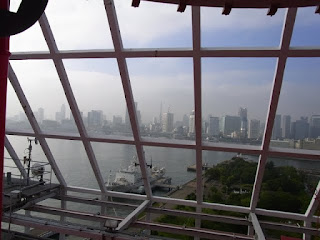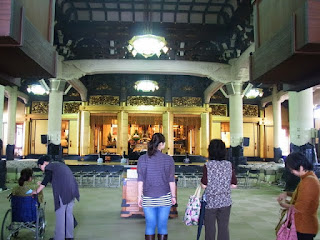In Lumine Est at Shinjuku. Look hard... there's a major problem.
Monday, 25 October 2010
Wednesday, 20 October 2010
Monday, 11 October 2010
More train manners - please do it again
Alternatively phrased - Don't push in !
For some reason the subway manners posters don't make it to our local subway station....
I wondered if we are already model commuters: Hiro thinks they consider us lost cause.
For some reason the subway manners posters don't make it to our local subway station....
I wondered if we are already model commuters: Hiro thinks they consider us lost cause.
Harumi urban redevelopment in Tokyo
Walking back we opted for the scenic route - along the Asashio canal. Whereas much of the centre part of Harumi island was fenced off bitumen, the western end of Asashio canal was was modern, upmarket, highrise. No vending machines, little shopping, manicured gardens, a Lexus shop (unusual since it's only recently that Toyota have been using the Lexus brand in Japan - a country where there was no historical stigma on cheap Japanese cars so no need to differentiate the upmarket models), a bicycle shop were the cheapest bicycles seemed to start at around 45,000Y ($450 or so US) - around here bikes start at less than half that, conspicuously no homeless people who often live along the river banks.
Despite the sanitised feel, the ambience was pleasant. It's easy to forget that Tokyo is - or at least was - a canal city, a water city. We wandered back through Tsukishima, an area most famous for monja, older and grungier, quite a different world. Depite the cultivated prettiness of gentrified Harumi, it also felt more human.
Despite the sanitised feel, the ambience was pleasant. It's easy to forget that Tokyo is - or at least was - a canal city, a water city. We wandered back through Tsukishima, an area most famous for monja, older and grungier, quite a different world. Depite the cultivated prettiness of gentrified Harumi, it also felt more human.
Harumi - low lying land
 |
| A new bridge under construction - the halt to plans to move the fishmarkets from Tsukiji to the other side of this bridge in Toyosu will no doubt mean a lot less traffic. |
 |
| Flood gates to side across to block off the streets in the event of typhoon, tsunami or higher than usual tides. |
 |
| The flood gates slide across and lock into place. |
Labels:
Harumi,
reclaimed land,
Tokyo,
Tokyo Bay
Sunday, 10 October 2010
Tsukiji to Harumi
Feeling full and happy we walked towards Harumi. All of the land here is reclaimed. I expected it to be more warehouse-like. I have been through this area before, mostly on a motor bike or going out to eat monja (more on that later), but I was surprised to see so much gentrification - many upmarket highrise among the industrial areas. It's walking distance to Ginza, which makes it easily gentrifiable.
 |
Crossing from Tsukiji area - the silver moon on the aparment building had me thinking it was a love hotel, but actually just an enthusiastic architect. |
 |
| Dredging I think, on the Sumidagawa (river) |
 |
| A little house on a canal next to the Sumida gawa. |
 |
Let's make a town (suburb) with no terrorists. Can't disagree with that, though I wonder how effective it would be in deterring committed terrorists.... |
 |
It seems like a seriously DINK area. Very double good income. This is a gym |
 |
| A car park with more than usual foliage |
 |
| A very hazy look at the Rainbow Bridge from Harumi |
 |
A MAFF (ministry of ag. forestry & fishing ship) docked at Harumi. Off limits to the public it probably spends its time chasing the Sea Shephard when not in port. |
It seems like whaling ships dock here
http://www.enlacelink.com/news/2010/mar/11/japan-arrests-whaling-activist-for-boarding-ship/
 |
| In front of Harumi Pier |
 |
Looking out on a hazy view from the Harumi Passenger Terminal - towards Shiodome. |
 |
| Harumi Pier Park from the obsevation deck |
 |
| A ship from the Korean Maritime University in port. |
Hakata Ramen
From Honganji we walked towards Harumi, past the pretty Tsukijigawa park and then back around to Harumi Dori (street). The ramen shope there - Fukuchan- piqued my interest. For Hiro it was a blast from the past. Befor the ramen boom that mean 'tonkotsu' (pork based) Kyushu style ramen was hard to come by in Tokyo. According to Hiro, for him, tonkotsu ramen = Fukuchan. The ramen was great, much much much better ramen than you usually get. Deep flavour without too much oil. They even had free boiled eggs sitting in baskets on the table.... I guess people don't try and fill their pockets on the way out... that said though how many boiled eggs could a person eat in a day....
 |
| Tsukijikawa |
 |
Lots of condiments, garlic, ginger, cabbage, wakame seaweed, preserved fish eggs, and another kind of pickle. Also soy, sesame, chili, chile oil & vinegar too perhaps. Note the eggs. |
 |
Hiro's Ramen - seconds - (you can order extra noodles once you've finished your noodles and yet another boiled egg - |
 |
My delicious ramen -with half a boiled egg and pork on top |
 |
| Fuku-chan Hakata Ramen |
Honganji, Tsukiji
If awards were being given out for the most untemple like temple in Japan, Honganji would be a strong contender. A Jodo shinshu sect temple, that's located not far from Tsukiji fish market, it looks rather more like an art gallery, or European parliament building than it does a Buddhist temple. I have passed it many times, usually when visiting Tsukiji markets or visiting a friend who was being treated at the National Cancer Centre across the road, but never popped in to see it.
Today was the day, inspired partly by Katsu, a friend in Kyoto who suggested it, partly because it's somewhere that I have been meaning to go, and partly because the Tsukiji Harumi map was on the top of the walking tours of Tokyo pile that I picked up at Tokyo Metropolitan Govt a couple of weeks ago.
In terms of architecture, Honganji is obviously different, but more striking for its difference was the attitude. I get a headache trying to discern the differences between Jodoshu, Jodoshinshu, Tendai, Soto Zen, Rinzai Zen, Nichiren and its manifestations, Shingon and any and all sects that I haven't mentioned, but Honganji's Jodoshinshu was the first time to see what appeared as inclusive Buddhism in Japan. Hiro was hungry so we didn't stay long, though I was interested to note they have English seminar there each month (just what I might need if I am ever going to contribute to a Zen text translation project I agreed to do months ago when I had a whole lot more time).
I intend to go back again someday to check out out in more detail.
 |
| Honganji |
 |
Chanting for what looked like a memorial ceremony up the front
other people were coming and going as they pleased.
|
 |
In such a grand marble building in Europe, I doubt cattle would be
the animals on the bannisters.
|
 |
| ditto |
 |
| Looking out to a courtyard
Unorthodox for a Japanese temple..
|
 |
| Detail above the door |
http://tsukijihongwanji.jp/tsukiji/index_e.html The link to the temple homepage.
Sunday, 3 October 2010
The Public Transport Shame File
The 'no peeing here' signs that you see around and about in odd places made a whole lot more sense today. This morning inside Akihabara station, opposite a newspaper stand, I passed a man standing in a corner peeing....
Despite the fact that there was a public toilet less than 100m from him. He was probably mid twenties, old enough to know better, young enough to know better too for that matter....
He makes the shame file.

 |
| Busted! |
Saturday, 2 October 2010
Day Zero
First of October, Day Zero, life as a graduate student has begun....
I managed to have an altercation with the first teacher I encountered... the head of Japanese language.... apparently notorious for her inflexibility. Mindless inflexibility ... a feature of Japanese institutions. In a rather raised voice she told me I 'shouldn't be studying Japanese' and walked out of the classroom.... hmmm.
Language classes don't count to Masters units - but they get calculated as part of a student's GPA (Grade Point Average). Attendance is very strict and there is a test every lesson. I asked if there is some way around this - like could I come as an unregistered student.
A. NO! We don't allow students to come and just sit in. It's a bother for the teacher.
Q. But if I give an assurance that I will participate fully and do my homework seriously.
A. No.
Q. But I want to learn Japanese.
A. Well You shouldn't work.
Q. But I can't stop working in the middle of a university term when I committed to it in February.
A. YOU SHOULDN'T BE STUDYING JAPANESE.
hmmm..
not very encouraging.
Lucky I am a tough cookie...
Lucky I am a tough cookie...
I sent a letter this morning pointing out that the attitude conflicts with the blurb on the Uni website:
The Masters Program...'encourages the study of Japanese' and developing a competent grounding in Japanese and/or other second or third languages.
It's false advertising....the whole point of studying from a Japanese university was that I would be able to improve Japanese. I'll be quite upset if they won't be flexible.
It's false advertising....the whole point of studying from a Japanese university was that I would be able to improve Japanese. I'll be quite upset if they won't be flexible.
Happily my afternoon classes were interesting and fun - one on Global History, one on Nationalism.
But lots of homework for the weekend.
Subscribe to:
Comments (Atom)













